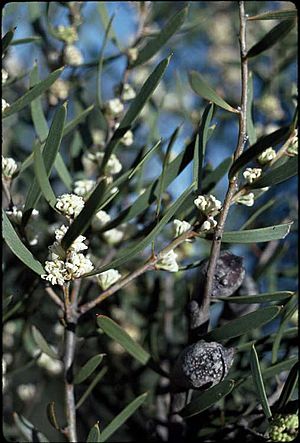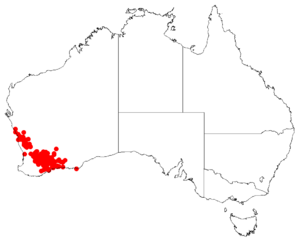Swan hakea facts for kids
Quick facts for kids Swan hakea |
|
|---|---|
 |
|
| Hakea cygna subsp. cygna near Tathra National Park | |
| Scientific classification | |
| Genus: |
Hakea
|
| Species: |
cygna
|
 |
|
| Occurrence data from Australasian Virtual Herbarium | |
Hakea cygna, often called the swan hakea, is a dense shrub that grows only in Western Australia. It has creamy-white flowers that stand upright. These flowers usually appear between July and August.
Contents
What is Hakea cygna?
The swan hakea is an upright shrub that can grow from 0.4 m (1 ft) to 2 m (7 ft) tall. Its smaller branches are covered with soft, flat, silky hairs, especially when it's flowering.
Leaves of the Swan Hakea
The leaves of this plant can look very different from one another. Some are flat and thick, while others are narrow and egg-shaped. Some might even be shaped like needles or triangles when you look at them closely. They are smooth and can be 2 cm (0.79 in) to 7.5 cm (3.0 in) long. They are also 1.2 mm (0.047 in) to 9 mm (0.35 in) wide. You can see clear veins along the edges of the leaves.
Flowers and Fruit
The swan hakea produces groups of 6 to 14 creamy-white flowers. These flower groups, called racemes, grow upright from where the leaves join the stem. The small stalks that hold each flower, called pedicels, are smooth and creamy-white. The flower itself, known as the perianth, is also creamy-white. The part of the flower that receives pollen, called the style, is about 5.5 mm (0.22 in) to 7 mm (0.28 in) long.
After flowering, the plant grows oval or egg-shaped fruits. These fruits are 2.1 cm (0.83 in) to 3.7 cm (1.5 in) long and 1.2 cm (0.47 in) to 2 cm (0.79 in) wide. They grow at an angle on a short, thick stalk. The fruit has a small, noticeable point. Inside, the seeds are pale brown with darker lines. They are broadly egg-shaped or almost triangular and 12 mm (0.47 in) to 20 mm (0.79 in) long. Flowers can appear from May to June or from August to September.
Naming the Swan Hakea
Hakea cygna was first officially described by a scientist named Byron Barnard Lamont in 1987. He published his findings in a science journal called the Botanical Journal of the Linnean Society.
Why "Cygna"?
The second part of the plant's name, cygna, comes from the Latin word cygnus. This word means "swan". It was chosen because the shape of the fruit is thought to look a bit like a swan.
Different Types of Swan Hakea
There are two main types, or subspecies, of Hakea cygna:
- Hakea cygna subsp. cygna: This type has flat, thick, and narrow egg-shaped leaves. They are 2.5 mm (0.098 in) to 9 mm (0.35 in) wide. You can find this subspecies mainly south of Lake King.
- Hakea cygna subsp. needlei: The leaves of this type can vary a lot. They might be narrow and linear, shaped like needles, or triangular. They are usually 1.2 mm (0.047 in) to 2 mm (0.079 in) wide.
Where Does it Grow?
The swan hakea is found across a wide area of Western Australia. It grows from Geraldton in the north, all the way to Ravensthorpe in the south-east, and east to Cape Arid.
Preferred Habitat
This plant likes to grow in areas with heath (low-growing shrubs) or mallee-heath (a type of eucalyptus woodland). It prefers gravelly or sandy soils, which can be white, yellow, or grey. Often, these soils are found over a hard layer called laterite.
Where the Subspecies Live
- Subspecies cygna is common from Eneabba in the north, through the wheatbelt region of Western Australia to Merredin, and south to Esperance.
- Subspecies needlei is found in fewer places. You can find scattered groups of this plant just south of Lake King and in the Pallarup Nature Reserve.
Conservation Status
The subspecies Hakea cygna subsp. needlei is listed as "Priority Two" by the Western Australian Government's Department of Parks and Wildlife. This means that not much is known about this plant, and it is found in only a few locations. Scientists are still learning about it and keeping an eye on its populations.

